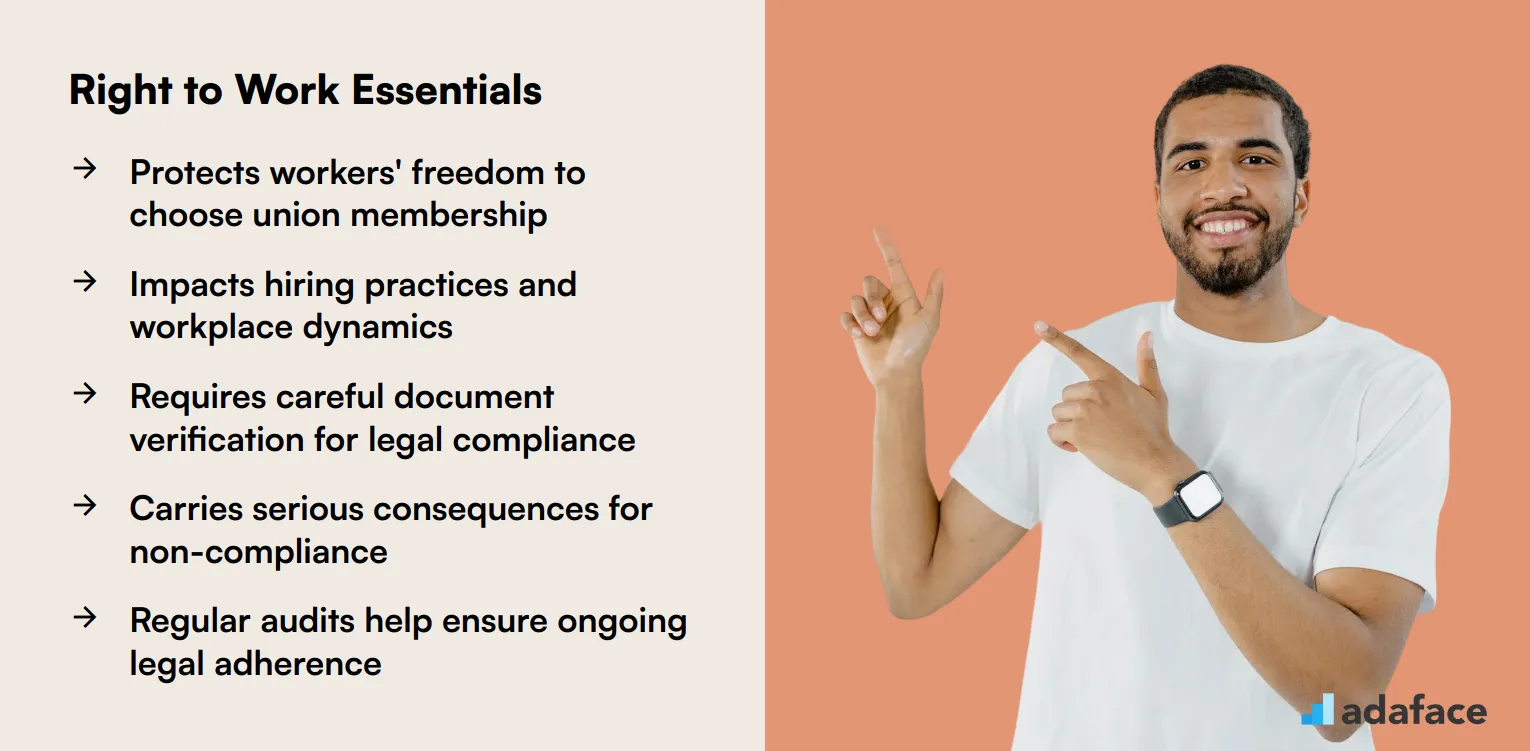Understanding the 'Right To Work' is crucial for recruiters to ensure compliance with employment laws. This concept refers to the legal right of an individual to work in a specific country, which is a key factor in talent acquisition.
Recruiters must verify this right to avoid legal repercussions and maintain a fair hiring process. Conducting proper checks can prevent issues like employee ghosting and ensure a smooth onboarding experience.
Table of contents
Right To Work: What Does It Really Mean?
Right to work is a fundamental employment principle that ensures individuals can seek and accept work without being required to join a labor union. It protects workers' freedom to choose whether or not to associate with a union, while still allowing them to benefit from collective bargaining agreements.
In countries with right to work laws, employees cannot be compelled to pay union dues or fees as a condition of employment. This concept aims to promote individual liberty and prevent forced unionization, allowing workers to make their own decisions about union membership.
For recruiters and HR professionals, understanding right to work is crucial when hiring in jurisdictions with such laws. It's important to ensure that job offers and employment contracts comply with right to work regulations, respecting employees' choices regarding union participation.
Right to work can impact workplace dynamics and labor relations within an organization. While it may lead to reduced union membership and potentially weaker collective bargaining power, proponents argue it fosters a more competitive job market and gives workers greater individual freedom.
When conducting interviews or onboarding new employees in right to work states, HR professionals should be prepared to explain the implications of these laws. Clear communication about employees' rights and options regarding union membership can help avoid misunderstandings and potential legal issues.
Who Needs To Prove Their Right To Work?
In the UK, all employers are legally required to verify the right to work status of their employees. This applies to both British and non-British citizens, regardless of their nationality or how long they've lived in the country.
Employers must conduct right to work checks for every person they intend to employ. This includes full-time, part-time, temporary, and casual workers, as well as contractors and self-employed individuals who are not employed through their own limited company.
It's important to note that employers cannot discriminate based on race, nationality, or ethnic origin when conducting these checks. The same process must be applied consistently to all potential employees, regardless of their appearance or accent.
Employers are responsible for maintaining records of these checks for the duration of employment and for two years after the employment ends. Failure to properly conduct and document right to work checks can result in significant fines and penalties for the employer.
In some cases, additional checks may be required for certain roles or industries. For example, jobs in healthcare, education, or financial services may require enhanced background checks or specific qualifications.
Acceptable Documents for Right To Work Checks
When conducting right to work checks, employers must verify specific documents to ensure an individual's legal right to work in the country. The UK government provides a comprehensive list of acceptable documents for this purpose, which are divided into two main lists: List A and List B.
List A documents prove that the holder has an ongoing right to work in the UK. These include a UK passport, a biometric residence permit showing indefinite leave to remain, or a birth certificate along with an official document showing the individual's National Insurance number.
List B documents are for those with a time-limited right to work in the UK. This list includes items such as a current passport with a valid visa, a biometric residence permit with limited leave to remain, or a frontier worker permit.
Employers must carefully examine these documents to verify their authenticity and ensure they belong to the person presenting them. It's crucial to keep copies of the checked documents and record the date of the check for compliance purposes.
In some cases, employers may need to conduct follow-up checks for individuals with time-limited work permissions. This ensures continued compliance with right to work regulations throughout the employment period.
How To Conduct a Right To Work Check
Conducting a Right to Work check is a straightforward process, but it requires attention to detail to ensure compliance with legal requirements. Begin by obtaining original documents that prove the candidate's right to work in the country, such as a passport or a visa.
Next, verify the authenticity of these documents by checking for any signs of forgery and confirming that the details match the candidate's identity. This step is crucial in preventing unfair hiring practices, which can lead to legal issues for your organization.
Take a clear copy of the documents and store them securely for record-keeping, as you may need to present them in case of an audit. Make sure the copies are legible and include the date when the check was conducted.
Finally, maintain a regular schedule for re-checking the documents, especially for employees with limited rights to work, ensuring that their status remains valid throughout their employment. This proactive approach helps in managing your employment status records effectively.
What Happens If An Employee Doesn't Have The Right To Work?
Employing someone without the right to work can lead to serious consequences for both the employer and the employee. The employer may face hefty fines, legal action, and damage to their reputation, while the employee could be deported or face criminal charges.
In the UK, employers can be fined up to £20,000 per illegal worker. Additionally, employers who knowingly hire illegal workers may face imprisonment for up to 5 years and an unlimited fine.
The employee's contract may be considered void, meaning they have no employment rights. This could result in loss of wages, benefits, and any potential claims against the employer.
Employers are required to terminate the employment of individuals found to be working illegally. Failure to do so can result in further penalties and potential closure of the business.
To avoid these issues, employers should conduct thorough right to work checks before hiring. Regular audits of employee documentation can help ensure ongoing compliance with immigration laws.
Right To Work: Staying Compliant and Avoiding Penalties
Ensuring compliance with Right to Work regulations is an important responsibility for recruiters and HR professionals. Failure to verify an employee's right to work can lead to significant penalties, including fines and legal action.
Employers must familiarize themselves with the necessary documentation required to establish an individual's eligibility to work. This typically includes passports, visas, or work permits, depending on the country and specific circumstances.
It is advisable to maintain a systematic process for verifying and recording these documents during the hiring process. This not only helps in staying compliant but also in keeping accurate records for future reference.
Regular audits of employee records can help identify any potential issues or expired documents that need updating. By proactively managing these records, employers can avoid costly penalties and ensure a smooth hiring process.
Staying informed about any changes in Right to Work laws is crucial for maintaining compliance. Engaging in talent acquisition strategies that prioritize these checks can enhance the overall recruitment process.

Conclusion: Mastering Right To Work Checks
Understanding and implementing Right To Work checks is a key responsibility for HR professionals and recruiters. By following the guidelines outlined in this post, you can ensure your organization remains compliant with employment laws and avoids potential penalties.
Remember, Right To Work checks are not just a legal formality but a way to create a fair and inclusive workplace. Stay informed about any changes in legislation and regularly review your processes to maintain best practices in recruitment and employee onboarding.
With this knowledge, you're now equipped to conduct Right To Work checks confidently and effectively. Happy hiring!
Right To Work FAQs
Employers can prevent ghosting by maintaining clear communication, setting expectations early, and ensuring a positive candidate experience.
Ghosting is on the rise due to increased job options and digital communication, making it easier for candidates to disappear without notice.
Common documents include passports, visas, and work permits, depending on the country and individual circumstances.
Employers may face legal penalties, fines, and damage to their reputation if they employ individuals without the Right To Work.
Right To Work checks should be conducted before employment begins and regularly updated if the employee's status changes.

40 min skill tests.
No trick questions.
Accurate shortlisting.
We make it easy for you to find the best candidates in your pipeline with a 40 min skills test.
Try for freeRelated terms



